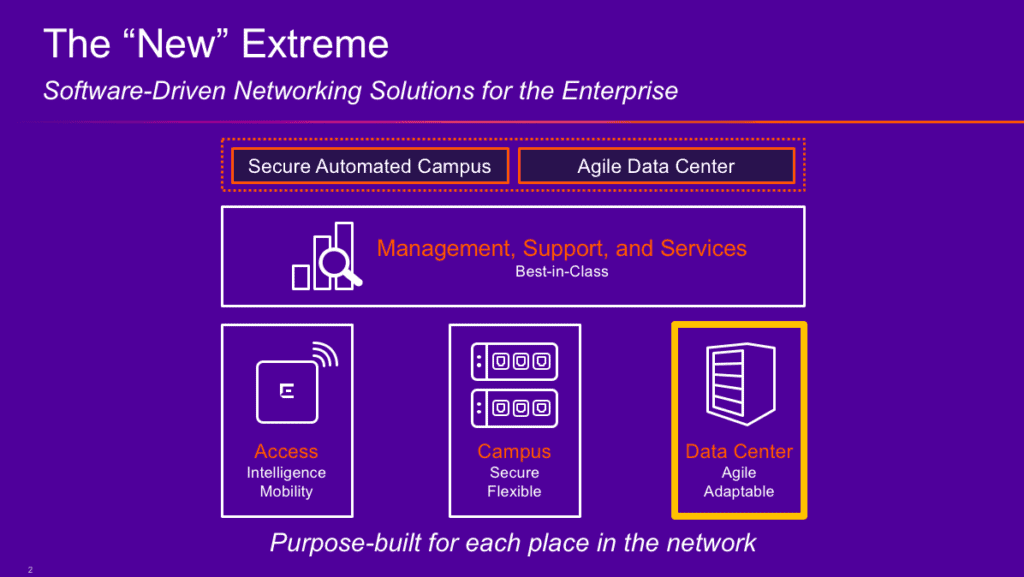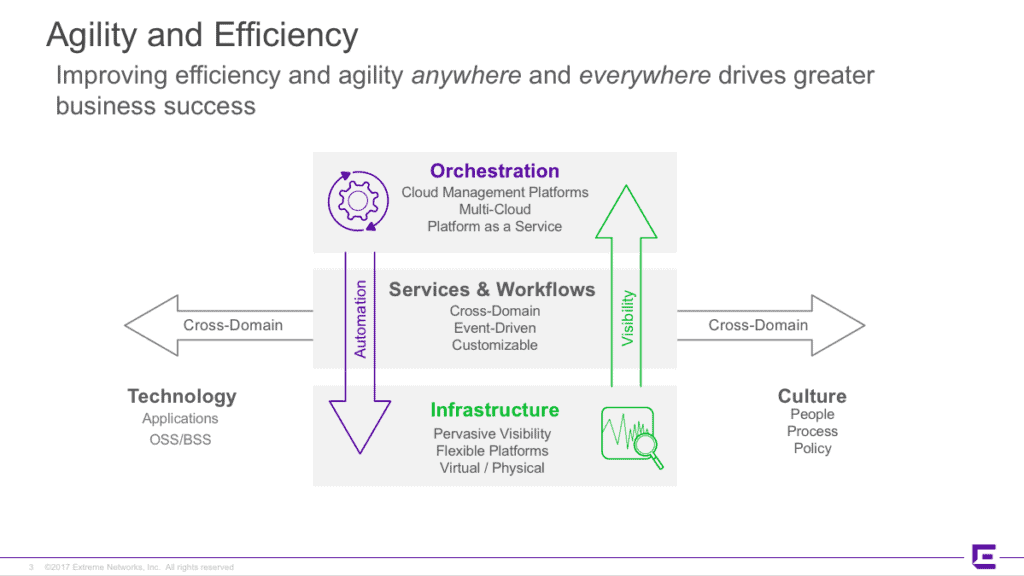When your name is an adjective, you’re just asking to be the brunt of many punishing puns. Based on the chatter during the second day of NFD17, that is certainly true for Extreme Networks. In fact, it’s actually hard to avoid. So let’s just dive right in to extreme automation, with Extreme Networks. I hope you find it extremely interesting, extremely informative, and… Well, that’s probably enough. For now.
Extreme Acquisitions
Let’s take a quick diversion before we get into the nuts and bolts of Extreme automation. Even for those of you who don’t follow industry news, the pedigree of “the new Extreme” and their automation tools is worth understanding a bit.
It all starts in the mid 90s, around 1994-1996. That is when Foundry Networks, Brocade, Extreme Networks, and several other networking or networking adjacent companies were founded (like Avaya, and Bay Networks, etc.). Eventually, Brocade bought Foundry (in 2008), and then Extreme bought the SRA (Switching, Routing, and Analytics) business line from Brocade (in 2017). So you can think of Extreme Network’s new Data Center business as a continuation of the work started at Foundry and fostered at Brocade. Some of the team members have even made it through both acquisitions and remain dedicated to a product line that’s been developing for decades.
In fact, according to Wikipedia, “through a series of historical and contemporary merger and acquisition activity, Extreme Network claims an industry lineage that includes, at a minimum, the networking-focussed elements of the following companies: Digital, Chantry, Siemens, Cabletron, Enterasys, AirDefense, Symbol, Motorola, Zebra, Wellfleet, SynOptics, Bay Networks, Nortel Networks, Avaya, Vistapointe, StackStorm, Foundry Networks, [and] Brocade.” That’s certainly an extreme set of companies to be rolled up under one (purple) umbrella: The New Extreme.
Extreme Automation
When we’re talking about automation, one of those acquisitions stands out: StackStorm.
StackStorm launched in 2013, came out of stealth mode in 2014, released version 1.0 in 2015 (open source, no less), picked up clients like MasterCard, Netflix, SendGrid, and Target, and then sold to Brocade in 2016. What a ride that must have been!
Once acquired, Brocade SRA went to work adding network automation to the existing data center operations automation software, in order to “bring DevOps style scalable open source automation to Brocade’s networking solutions.” They left StackStorm completely open source, and built WorkFlow Composer on top, to add ‘enterprise-grade’ features like security, support, and even a cool graphical interface (workflow designer).
Extreme Automation, powered by StackStorm, built by Brocade.
Everyday Automation
Two of the key themes that everyone wanted to talk about at NFD17 were automation/orchestration/intent and visibility/analytics/telemetry. That was no surprise. A bit more interesting, and refreshing, was the focus on automation beyond “day 0” infrastructure provisioning and “day 1” service provisioning to “day 2” operations as well. A focus on Everyday Automation.
NetOps spend most of their time monitoring, troubleshooting, and remediating; network automation needs to address that. #NFD17 https://t.co/9PDs7QuG2G
— Chris Grundemann (@ChrisGrundemann) January 25, 2018
Extreme seeks to provide the tools that network operators need, everyday, with a focus on cross-domain agility and efficiency, and a combination of bottom up visibility and top down automation.
The tools themselves are mostly applications or templates built on top of StackStorm:
- StackStorm – Open source automation platform that combines sensors, rules, and actions into workflows that use an IFTTT style of automation that is easy to grasp and powerfully flexible
- Workflow Composer – The commercial version of StackStorm, which adds a design UI, role based access control, LDAP, automation suites, and global support
- Workflow Designer – The graphical design interface built into Workflow Composer that makes building workflows as easy as programming with Scratch (a visual programming language for kids)
- Automation Suites – These are how Brocade SRA added networking to StackStorm, there are two of them; Network Essentials and Data Center Fabric, they both add building blocks and templates that can be used to build network automation workflows with VDX, MLX, and SLX devices
- Integration Plugins – Webhooks, APIs, applications, and other tools to tie third party elements into your automated workflows, this includes the sensor side from SIEMs and firewalls, as well as the actions side with NAPALM and Jinja templates, etc…
- Flow Optimizer – An app that was part of Brocade’s Open Daylight based SDN controller, which is now being repurposed as part of Extreme Network’s automation tool chain – it is a “visibility policy engine” that can now bolt into Workflow Composer to listen to flows from the network and provide visibility, or drop them as needed
Extreme Demonstrations
I could go on and on about how extremely simple they’ve made network automation, but you’d probably rather see it for yourself.
Ram Golla, Senior Product Manager, demonstrates how Extreme Workflow Composer integrates with cross-domain tools to provision, validate, and troubleshooting a new server into a data center network.
Ram Golla, Senior Product Manager, demonstrates how Extreme Workflow Composer integrates with cross-domain tools such as Splunk to automatically detect and remediate a network service outage.
Yousuf Hasan, Senior Manager, Product Management, demonstrates how Extreme Workflow Composer and Flow Optimizer can automatically detect and remediate a DDoS attack.
Tl;dr:
There are a few key takeaways here:
- Automation needs to be about more than just provisioning, it needs to help us with the tasks we spend most of our time on, like monitoring, troubleshooting, and remediation
- Automation also needs to be simple and approachable for it to be adopted in the enterprise, most companies just don’t have the ability to build, and maintain, a bunch of custom scripts and software tools (and they shouldn’t have to)
- Greenfield utopia’s are almost always a pipe dream, and there’s lots of other reasons (and requirements) to build a multi-vendor IT infrastructure, so your automation ecosystem needs to be open to integration
- The “new” Extreme Networks is a formidable networking company, (re)built through a series of acquisitions that include some of the industries best tools, teams, and technologies – and they seem to ‘get it’
While I have to admit that I hadn’t been thinking about Extreme Networks as one of the top networking companies, this dive into extreme automation has definitely made me think twice about that.









[…] Extreme Automation with Extreme Networks (& StackStorm) […]